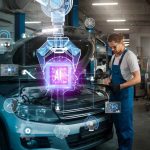Modern cars have come a long way from their humble beginnings as basic transportation vehicles. In today’s fast-paced world, the automotive industry is constantly evolving, with innovative technologies shaping the way we drive and interact with our vehicles. From advanced safety features to cutting-edge entertainment systems, let’s dive into the world of new technologies in modern cars.
Advanced Driver Assistance Systems (ADAS)
Modern cars are equipped with Advanced Driver Assistance Systems (ADAS) that make driving safer and more convenient. These systems include features like adaptive cruise control, lane-keeping assist, automatic emergency braking, and blind-spot monitoring. ADAS technologies use sensors and cameras to detect potential hazards and assist the driver in avoiding accidents.
Electric and Hybrid Powertrains
The rise of electric and hybrid vehicles is transforming the automotive landscape. Electric cars are powered solely by electricity, producing zero emissions, while hybrid cars combine traditional gasoline engines with electric motors for improved fuel efficiency. These technologies are helping reduce our carbon footprint and promote a cleaner environment.
Infotainment Systems
Modern cars are equipped with state-of-the-art infotainment systems that keep drivers and passengers connected and entertained. These systems feature touchscreen displays, voice recognition, and smartphone integration, allowing users to access navigation, music, and apps with ease.
Autonomous Driving Technology
The dream of self-driving cars is becoming a reality, thanks to autonomous driving technology. Companies like Tesla and Waymo are at the forefront of developing self-driving vehicles that can navigate without human intervention. While fully autonomous cars are not yet widespread, they represent a promising future for the automotive industry.
Connected Car Technology
Connected car technology allows vehicles to communicate with each other and with infrastructure like traffic lights and road signs. This technology can enhance traffic management, reduce congestion, and improve overall road safety. Moreover, it enables features like remote vehicle diagnostics and over-the-air software updates.
Augmented Reality Head-Up Displays
Augmented Reality (AR) head-up displays are changing the way drivers perceive information. These displays project vital data, such as navigation instructions and speed limits, directly onto the windshield. This allows drivers to access essential information without taking their eyes off the road.
Improved Fuel Efficiency
Car manufacturers are continually working on improving the fuel efficiency of their vehicles. Technologies like direct fuel injection, turbocharging, and lightweight materials help reduce fuel consumption and greenhouse gas emissions. This benefits both the environment and consumers’ wallets.
Enhanced Safety Features
Safety is a top priority in the automotive industry, and modern cars are equipped with an array of safety features. These include airbags, antilock brakes, stability control systems, and tire pressure monitoring. Newer technologies, such as pedestrian detection and automatic emergency braking, add an extra layer of protection.
Sustainable Materials
Car manufacturers are increasingly using sustainable materials in the production of vehicles. Recycled plastics, eco-friendly upholstery, and bio-based components are being incorporated to reduce the environmental impact of car manufacturing.
Advanced Lighting Systems
Modern cars feature advanced lighting systems, such as LED and adaptive headlights. These systems improve visibility at night and in adverse weather conditions, enhancing overall safety on the road.
Vehicle-to-Everything (V2X) Communication
V2X communication allows vehicles to communicate not only with each other but also with infrastructure and pedestrians. This technology has the potential to reduce accidents and traffic congestion by providing real-time information and warnings to drivers.
Personalization and Customization
Car manufacturers are offering more customization options than ever before. From interior color schemes to performance settings, drivers can tailor their vehicles to suit their preferences and lifestyles.
Eco-Friendly Paints and Coatings
Even the paint on modern cars has become more eco-friendly. Water-based and low-VOC (volatile organic compounds) paints are used to reduce the release of harmful chemicals into the environment.
Improved Battery Technology
Electric and hybrid cars are benefiting from advancements in battery technology. Newer batteries offer longer ranges, faster charging times, and increased durability, making electric vehicles more practical for everyday use.
Enhanced Security Systems
As cars become more connected, security becomes a growing concern. Manufacturers are implementing robust security systems to protect vehicles from cyber threats and theft.
In conclusion, the automotive industry is embracing a wave of new technologies that are revolutionizing the way we drive and interact with our vehicles. From safety and sustainability to connectivity and automation, these innovations are making modern cars more efficient, enjoyable, and environmentally friendly.
Frequently Asked Questions (FAQs)
- Are electric cars the future of the automotive industry?
Yes, electric cars are gaining popularity and are considered a significant part of the future of the automotive industry. They offer environmental benefits and are becoming more accessible to consumers.
- What is the difference between hybrid and electric cars?
Hybrid cars have both a gasoline engine and an electric motor, while electric cars run solely on electricity and do not have a gasoline engine. Hybrid cars offer better fuel efficiency but still rely on gasoline to some extent.
- How do autonomous cars work?
Autonomous cars use sensors, cameras, and artificial intelligence to navigate and make driving decisions without human intervention. They analyze their surroundings and follow predefined rules to ensure safe travel.
- Is it safe to use autonomous driving technology?
Autonomous driving technology is continually improving and becoming safer. However, it is essential for drivers to remain vigilant and be prepared to take control of the vehicle if needed, especially during the transition to fully autonomous systems.
- What are some eco-friendly materials used in car manufacturing?
Car manufacturers are using materials like recycled plastics, sustainable upholstery, and bio-based components to reduce the environmental impact of car production. These materials help conserve resources and reduce waste.








